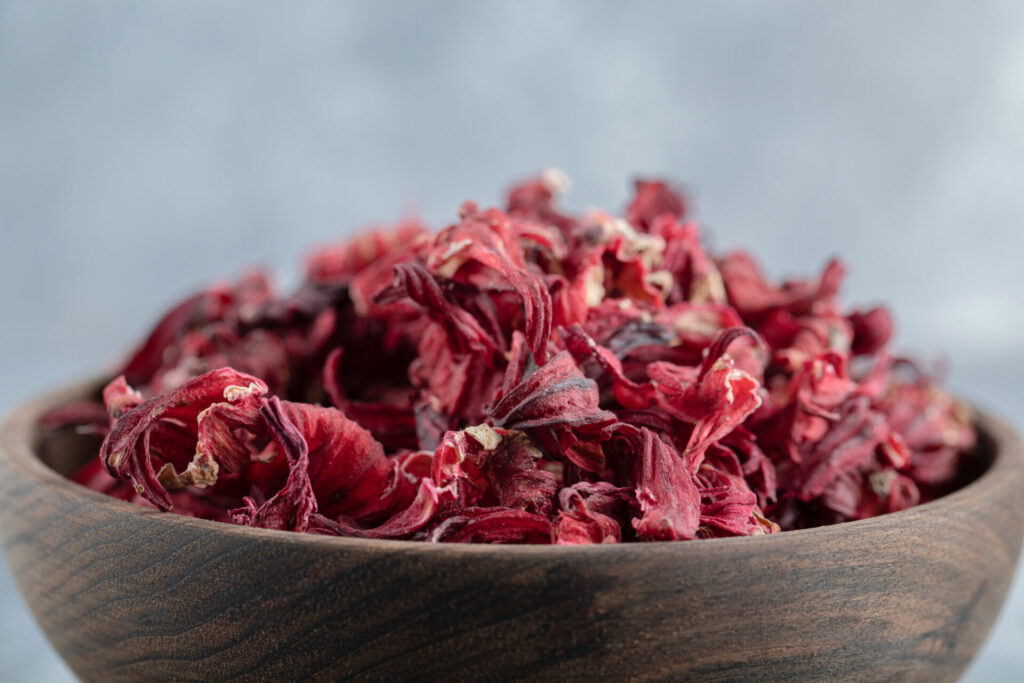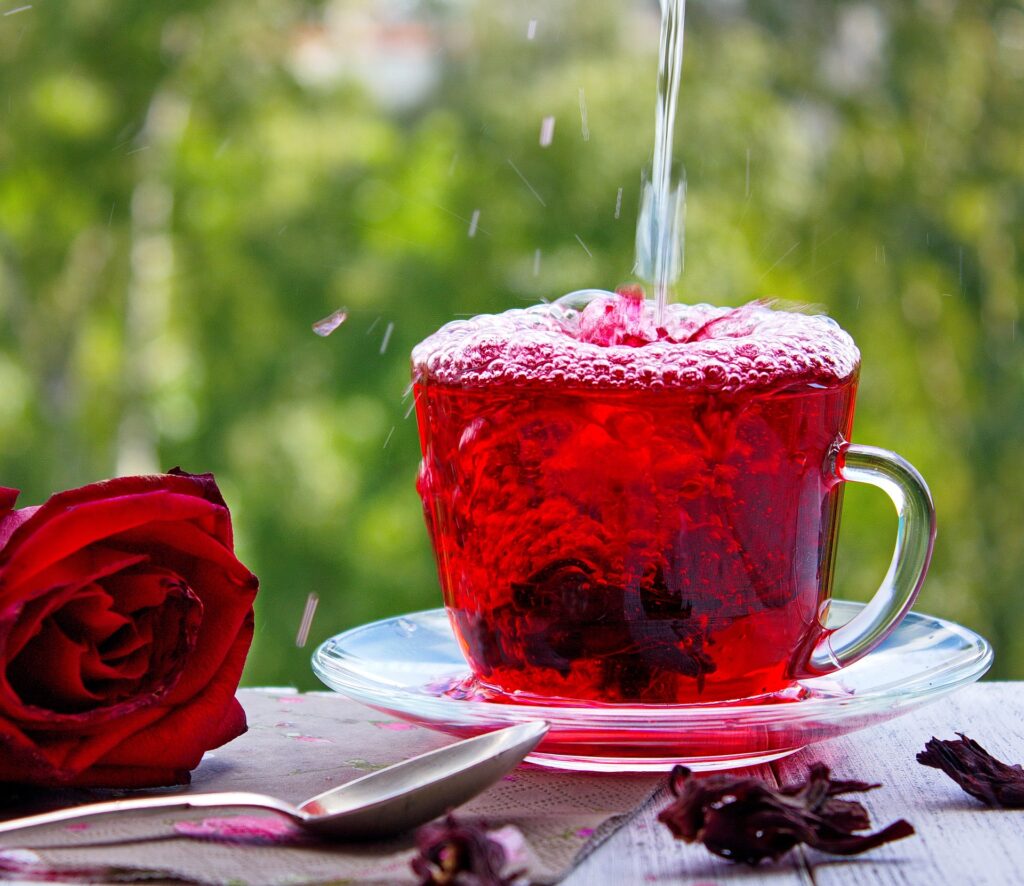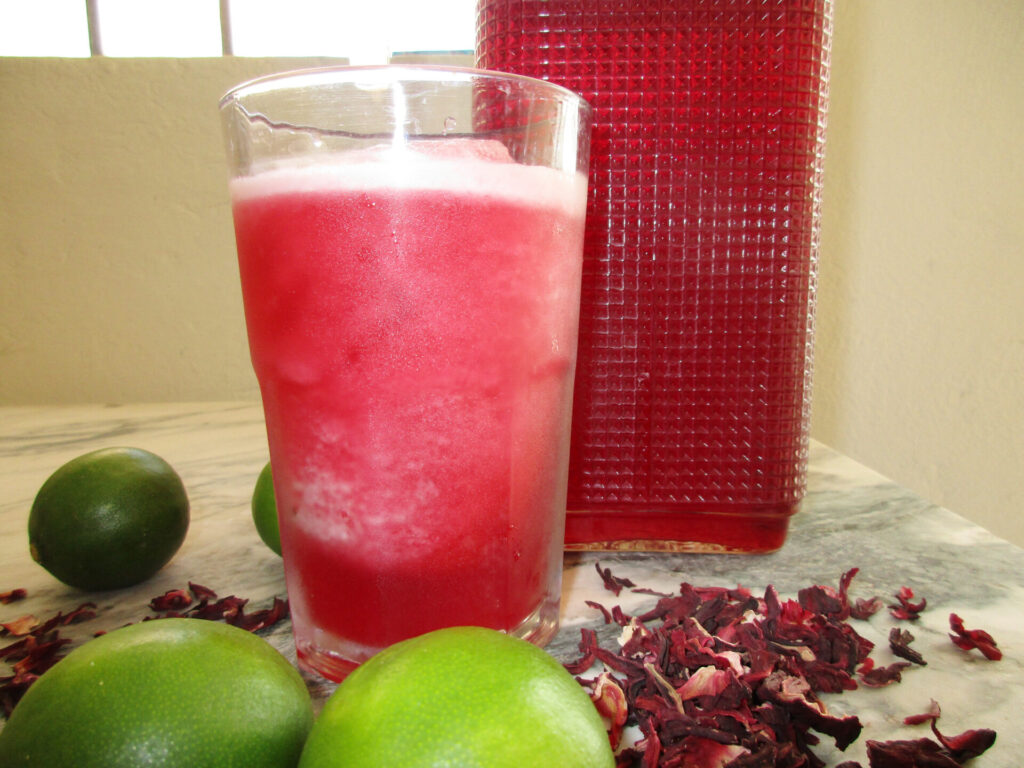Deep ruby-red hibiscus flowers are colorful and they make a delicious, healthful tea! Learn about why hibiscus flower tea is a great summer beverage that has numerous health benefits, and how to make it.
If you’ve had the chance to enjoy an iced hibiscus tea, you’ll know about the great tangy taste of this cooling beverage. But did you also know that hibiscus flower tea is a prized natural remedy?
The petals or calyxes of the hibiscus flower (Hibiscus sabdariffa) also known as Roselle, Roselia, or Red Sorrel, are used to make either an iced or hot tea. Because hibiscus thrives in semi-tropical to tropical climates, you’ll find dried hibiscus flowers in several African countries, throughout Central and South America, in Asia, the Middle East, and even in southern European countries, such as Italy. From bustling cantinas in Mexico to crowded street stalls in Egypt, hibiscus tea is a favorite.

Hibiscus tea is beautiful and tasty, and it has many known health benefits. You’ll often find hibiscus as an ingredient in herbal teas due to its high level of antioxidant anthocyanins (the natural polyphenol that also makes the lovely color) and its signature tangy flavor. Hibiscus is good for health in so many ways.
You can buy hibiscus tea in regular tea bags. If you love hibiscus tea and want to take it over time for health, you can also buy the loose dried flowers. Dried hibiscus flowers will last a long time, so you can safely buy them in bulk and save some money! Just be sure to buy organic dried hibiscus flowers so you don’t get nasty pesticide residue along with your healthful tea!
Here are just a few reasons to drink hibiscus tea:
Health Benefits of Hibiscus Tea
1. High in Vitamin C
Hibiscus flowers are high in Vitamin C. They help fight coughs and strengthen the immune system.
2. Heart Healthy
Hibiscus is high in bioflavonoids, the natural plant chemicals that treat hypertension with no side effects! Hibiscus reduces blood pressure and also helps regulate blood cholesterol levels.
Note: If you have low blood pressure, consult your physician before adding hibiscus to your diet — you may not need to lower your blood pressure more!
3. High in Iron and Other Minerals
One of the great benefits of hibiscus is that it’s mineral-rich, including iron, calcium, niacin, thiamine, and phosphorus. Hibiscus is a great natural remedy for anemia and can be taken daily as a tea to increase vigor and stamina.
4. Helps Memory and Brain Health
Flavonoids particular to hibiscus are neuro-protective and can help improve memory. They may be effective in preventing Alzheimer’s Disease.

5. Balances Hormones in Women
Hibiscus, with its balancing and cooling properties, is an effective treatment for reducing menopausal hot flashes. It’s also good for soothing menstrual cramps.
6. Anti-Inflammatory, Reduces Fever
Drinking hibiscus flower tea helps prevent the onset of colds and flu while stimulating immunity. With its cooling effects, hibiscus tea is excellent for lowering fevers and reducing body heat in summer.
Note: Avoid hibiscus if you’re experiencing severe chills.
7. Calming and Anti-Depressive
Another great result of drinking hibiscus tea is that it’s calming and can relieve feelings of depression (especially during women’s monthly cycle). In general, hibiscus has a “brightening” effect on mood levels.
8. Digestive Aid
Hibiscus tea is excellent for digestion, helps to relieve constipation, and improves urinary tract health.
9. Improves Hair and Scalp Health
The flavonoids, vitamins, and minerals in hibiscus tea encourage hair growth from the inside out. To help improve hair quality, you can also make a paste of dried hibiscus flower powder (just grind the dried flowers in a spice mill) and apply it to the scalp. Leave on for at least ½ hour and rinse out.
With the additional use of hair oil made from ground hibiscus leaves and hibiscus flower powder, many find that gray hair is reduced and their hair returns back to its normal color. This will take time, however, and is not an overnight process.

How To Make Hibiscus Tea and Other Options
Hibiscus is very tart. So, it is usually sweetened to taste.
1. Iced Tea – steep hibiscus flowers in hot water and sugar, or your favorite natural sweetener; you can add a few squeezes of lime or lemon juice, refrigerate, and drink cold.
Optional variations:
For Flor de Jamaica, the favorite beverage of Mexico:
Boil water with sugar, chopped fresh ginger slices, and cinnamon sticks; then steep hibiscus flowers in the mixture. Strain and chill, then drink over ice.
For an Iced Hibiscus Frappé – Blend sweetened hibiscus tea, a few squeezes of lemon, and ice cubes. Drink immediately.
2. Hot Tea – Steep dried hibiscus flowers in hot water, strain, sweeten, and drink warm
3. Syrup – You can make a simple syrup of sugar and hibiscus flowers, with the addition of lemon juice. Strain and keep on hand to mix with other juices, pour it over ice cream or yogurt, or blend into chia pudding – there are so many tasty uses for hibiscus syrup!
4. Hibiscus powder – Add dried hibiscus powder to drinks, smoothies, yogurt, chia pudding, etc.
Attributions: Featured image and image of dried hibiscus flowers by “azerbaijan_stockers” courtesy of Freepik.
Disclaimer: This post is for informational purposes only. Any material herein is the expressed opinion of the authors and is not a substitute for professional advice, diagnosis or treatment, nor has it been evaluated by any regulatory agency. All use of information herein is solely at the risk and discretion of the reader.